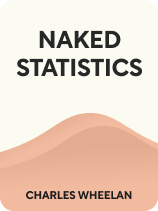

This article is an excerpt from the Shortform book guide to "Naked Statistics" by Charles Wheelan. Shortform has the world's best summaries and analyses of books you should be reading.
Like this article? Sign up for a free trial here .
How do people mislead with statistics? What are some real-world examples of misleading statistics?
Anyone with the will and a capable computer program can perform statistical analyses. This accessibility combined with the ease and speed of information sharing in our technology-oriented culture makes it easy for misleading statistics to make their way into our lives and inform our opinions or decisions.
Keep reading to find out how you can avoid falling into the trap of misleading statistics.
Statistics Make Data Meaningful and Actionable
Statistics are powerful tools for summarizing information and making inferences from data. He notes that people would have difficulty gleaning meaning from the mountains of data our society generates daily without them. Therefore, statistics make data meaningful and actionable.
The insights we generate with statistics help run society as we know it. For example, best practices in medicine and education are established via statistical analyses of data. Lawmakers use data to inform policy. Sports enthusiasts use data to discuss the skill and potential of their favorite players and teams, and the list goes on. We use statistics in so many ways that Wheelan reminds us that they inform our daily lives whether we realize it or not.
Dishonesty Disguised With Statistics
There is also a “dark side” of statistics that we become vulnerable to if we don’t educate ourselves about basic statistics concepts. Wheelan explains that the purposeful misuse of statistics is more common than we think.
Even though statistics are math-based, they’re not always objective, and we should interpret them with critical thinking and, in some cases, skepticism. While the values themselves can’t lie, the statistical tests that people choose to use, the data they choose to calculate statistics with, and the choice to include or not include specific statistics from datasets can construct various versions of “the truth.” For example, consider the following statements based on the same hypothetical dataset:
- Vote for Mark Smith! His tax cuts have saved the people in this town an average of $1,000 per year!
- Don’t vote for Mark Smith! His “tax cuts” have saved the wealthiest 1% of town residents tons of money and have saved low-income residents almost nothing!
Neither of these statements is a lie. Instead, different uses of data and statistics construct versions of the truth that best suit differing perspectives. While we can’t expect ourselves to dive into the underlying data for every statistic we read or hear, Wheelan explains that we can better spot incomplete or misleading information with a basic understanding of statistics.
| Misleading Statistics Darell Huff wrote an entire book about how people use statistics for deception. How to Lie With Statistics was published in 1954 and republished in 1993. According to Huff, one common way that people attempt to “lie with statistics” is to confuse their audience with seemingly precise figures that are actually irrelevant. For example, say you asked 30 families to survey the number of birds in their yard on a daily basis and send you their results. You tally them up and report that there are an average of 15.643 birds per yard in your neighborhood. This value looks very precise because of the three decimal places, but is virtually meaningless in reality. How did participants collect their data? How big was their yard? Do they live in the woods or the middle of town? The imprecision of the study is masked by the precision of the reported statistic. Another way that people use statistics to mislead an audience is to use impressive-looking values that are only tangentially related to the study. For example, say you’re marketing a “revolutionary” toilet bowl cleaning solution. You might truthfully report that “99.9% of users reported cleaner toilet bowls after scrubbing with your product!” Nearly 100% sounds impressive, until you realize that a scrubbed toilet bowl should always be cleaner than an unscrubbed toilet bowl, even with no chemical solution at all! A more useful and relevant statistic would be how much cleaner a toilet cleaned with your product is compared to your competitors’ products. |

———End of Preview———
Like what you just read? Read the rest of the world's best book summary and analysis of Charles Wheelan's "Naked Statistics" at Shortform .
Here's what you'll find in our full Naked Statistics summary :
- An explanation and breakdown of statistics into digestible terms
- How statistics can inform collective decision-making
- Why learning statistics is an exercise in self-empowerment






